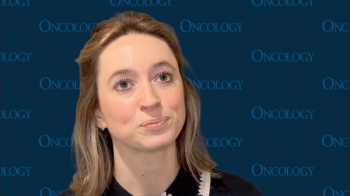
Oncology NEWS International
- Oncology NEWS International Vol 23 No 5
- Volume 23
- Issue 5
Earlier Unrelated BMT Is Effective in CML Subgroup
SEATTLE--Early donor matching and transplant appear to be particularly important in improving survival rates in chronic myeloid leukemia (CML) patients receiving unrelated donor marrow, John A. Hansen, MD, said at the plenary session of the American Society of Hematology annual meeting. In fact, he said, in selected patients, survival rates approach those of patients receiving marrow from HLA-identical siblings.
SEATTLE--Early donor matching and transplant appear to be particularlyimportant in improving survival rates in chronic myeloid leukemia(CML) patients receiving unrelated donor marrow, John A. Hansen,MD, said at the plenary session of the American Society of Hematologyannual meeting. In fact, he said, in selected patients, survivalrates approach those of patients receiving marrow from HLA-identicalsiblings.
The anticipated 3-year survival rate for CML patients in chronicphase who receive marrow from an HLA-identical sibling has beenabout 80%, while 2-year disease-free survival in patients receivingunrelated donor transplants has ranged from 36% to 45%.
The new study, conducted at the Fred Hutchinson Cancer ResearchCenter and the University of Washington, Seattle, showed 74% 3-yearsurvival in selected patients with HLA-matched unrelated donorsand early transplantation.
Dr. Hansen, professor of medicine at the University and head ofthe Human Immunogenetics Program at Fred Hutchinson, said thatthe study included 333 CML patients receiving non-T-cell-depletedbone marrow cells following cyclophosphamide and total body irradiation.Methotrexate and cyclosporine were administered after the transplantfor prevention of graft-versus-host disease (GVHD).
Although a majority of the patients in the study were HLA-A, B,DRB1 identical with their donor (75%), the remaining 25% involvedat least one minor donor mismatch for HLA-A, B, or DR antigens,Dr. Hansen said. Patient ages ranged from 5 to 55 years, witha median of 36 years.
The study found that, for patients under age 50, the probabilityof surviving 3 years post-treatment was 74% if transplantationfrom an HLA-matched donor occurred less than 1 year after diagnosisof CML.
In comparison, the 3-year survival rate dropped to 57% if transplantationwas done more than 3 years following diagnosis. Survival droppedeven further, to 40%, if the marrow was from a mismatched donorand transplantation was done more than 3 years after diagnosis.
In addition to duration of disease prior to transplant and degreeof donor match, patient age and stage of disease were also foundto be significant variables affecting outcome. Patients over theage of 50 had a poorer outcome than patients under age 50, andpatients under age 20 had the best outcome.
Looking at disease-stage-specific rates, 3-year survival was 60%for patients with CML in chronic phase, 39% for patients in acceleratedphase, 32% for those in second chronic phase, and 7% for thosein blast phase.
Dr. Hansen reported that severe GVHD was found to be more likelyin male patients transplanted from a female donor than with anyother gender combination. An HLA mismatch for a DRB1 allele wasmore likely to result in severe GVHD than were HLA matches orsingle mismatches for HLA-A or B antigens.
Those who received an unrelated donor transplant more than 3 yearsafter diagnosis were also more likely to die from transplantation-relatedcauses than those who were treated less than 3 years after diagnosis.
In another study at Fred Hutchinson and the University of Washington,presented at the ASH meeting (abstract 1151), HLA-C antigens werealso shown to be a risk factor for graft failure after unrelatedbone marrow transplant.
The data emphasize the importance of optimizing HLA matching anddonor selection relatively early in the course of CML, Dr. Hansencommented. In addition, new solutions to the problem of GVHD areneeded, he said.
Articles in this issue
almost 30 years ago
Taxol/Cisplatin Extends Survival in Advanced Ovarian Caalmost 30 years ago
Prostate Cancer Patients Face a Host of Psychosocial Issuesalmost 30 years ago
NSABP to Study Docetaxel in Operable Breast Canceralmost 30 years ago
Panel Recommends Approval of Talc for Malignant Pleural Effusionsalmost 30 years ago
ODAC Recommends Approval of Verluma for Staging of SCLCalmost 30 years ago
Minorities Lack Internet Access to Cancer Research Dataalmost 30 years ago
Fludarabine Produces CRs as First-Line CLL Therapyalmost 30 years ago
M.D. Anderson's C. Stratton Hill Receives Award From American Cancer Societyalmost 30 years ago
Managed Care: The View From Salick Managed CareNewsletter
Stay up to date on recent advances in the multidisciplinary approach to cancer.

















































































